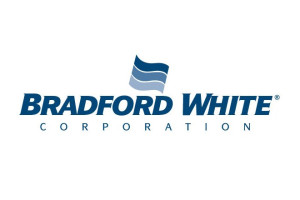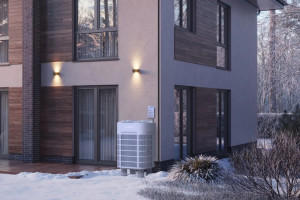
Bradford White Corporation, an industry-leading manufacturer of water heaters, boilers and storage tanks, is partnering with Pennsylvania's Energy Coordinating Agency (EC...
Approximately 100,000 Air Conditioners in Houston Area May be Damaged by Flooding and at Risk of Failure
Houston-area homeowners and businesses with properties damaged by the recent historical flooding are potentially facing looming problems with their climate control systems that may not be obvious to the untrained eye. Carrier and Air-Conditioning, Heating & Refrigeration Institute (AHRI), a trade association representing the heating, ventilating and air conditioning (HVAC) industry, are warning that standing water associated with flooding can result in system failure well after the water has receded. Carrier, a world leader in high-technology heating, air-conditioning and refrigeration solutions, is a part of UTC Climate, Controls & Security, a unit of United Technologies Corp. (NYSE: UTX).
“Standing water in a yard or house can damage a home’s heating and cooling system in ways that are not always readily apparent,” said Stephen Yurek, president and CEO of AHRI. “We advise homeowners to play it safe and replace, rather than repair, flood-damaged heating, cooling, and water heating equipment."
Carrier and its Houston-area representatives are urging homeowners to work with a local, licensed contractor to determine the status of their system.
“The best way is to get your system inspected is by a Texas-licensed dealer or installer,” said Zac Linde, president of Carrier Enterprise in Houston, a distributor of heating and cooling equipment. “It’s possible that a water-damaged unit is still operating and seems fine, but there could be problems. The best way to find out is to call in a local, reputable dealer who can show you what’s wrong and give you options on how and when to fix or replace the unit.”
More than 134,500 residences in the ten-county Houston area have been damaged or destroyed by Hurricane Harvey, according to a report from the Texas Division of Emergency Management.
Any air conditioning unit that has taken on water is potentially damaged. Most water-damaged units may need to be replaced, according to AHRI. A flooded home comfort system is similar to a flooded car. It may appear to operate normally, but may be prone to suffer serious problems due to the long-term impact of the water damage.
“Air conditioning units are designed to handle normal rain water, but not flood water,” said Sonny Roncancio, owner of Fresh Air, a Houston area Carrier Factory Authorized Dealer. “Just a few inches of water can contaminate the lines, damage the electrical parts and cause things like bearings to eventually seize. We’ve also seen a lot of units that were swept off their pads because of the flood-water current. One of two things may likely happen: the unit will fail or it will lead to poor indoor air quality if it keeps running.”
A system submerged in flood waters could contain substantial amounts of dirt and debris and may also become contaminated with various types of microorganisms such as bacteria and fungi. Additionally, moisture can collect in HVAC system components that were not submerged, like air ducts, which can also promote growth of microorganisms. Therefore, the Centers for Disease Control and Prevention recommends having all components of the HVAC system that were contaminated with flood water or moisture inspected, cleaned, and disinfected by a qualified professional.
While AHRI recommends replacing a water-damaged HVAC system, the timing of when to replace is important, according to Houston-area dealers.
“The vast majority of damaged homes and businesses are having drywall work done plus hardwood floors sanded,” says Corey Boyer, owner of Air Aide, a Houston service company. “In these cases consider whether it is best to wait to run the new system until the drywall work and floors are finished because you don’t want to circulate dust and debris through a new system. It will likely contaminate it.” Typically, the heating and cooling system is usually replaced near the end of a renovation project.
“People in damaged homes are dealing with so many problems. They often don’t know who to trust. And they are afraid of getting ripped off,” said Linde of Carrier Enterprise. “We work with a lot of dealers and repair centers. There are so many of them out there right now working hard, trying to get people back in their homes and deal with repair work.”
Here’s Linde’s advice:
Get the system inspected by a Texas-licensed technician. The company’s license number should be on its website, vehicles, printed material and in advertising.
Go to the Texas Department of Licensing and Regulation website, tdlr.texas.gov and use the search function to see if the company is licensed.
In addition, check out the Better Business Bureau and review websites, such as Home Advisor and Angie’s List. · Ask in advance what the cost of an inspection is, and when possible, get two quotes. Many dealers are providing discounted hourly repair-and-install rates.
Ask about pricing. Each home or business is different. Size of the dwelling is the most important factor in determining price, but many other issues come into play. If you can, get two bids and ask for advice based on your personal needs and income.
For more information about available rebates and financing programs go to carrier.com (click on Find a dealer) or call 1-800-CARRIER.

Bradford White Corporation, an industry-leading manufacturer of water heaters, boilers and storage tanks, is partnering with Pennsylvania's Energy Coordinating Agency (EC...

Bosch Home Comfort, a leading source of high-quality heating, cooling and hot water systems, is unlocking a new product category with the market launch of its latest inno...

The first annual John Hazen White III Memorial Tribute was held under sunny skies on Saturday, April 27, at Narragansett Brewery. It was a memorable day filled with unity...